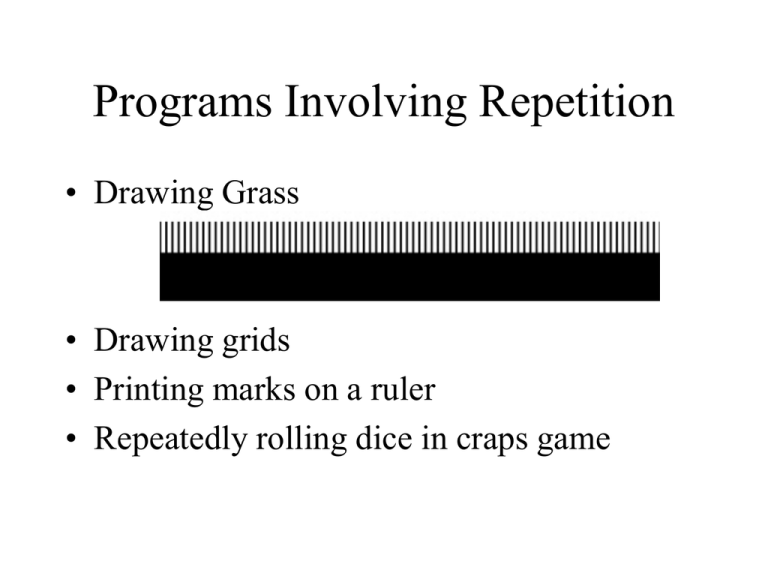Ch7 Control Structures
advertisement

Programs Involving Repetition
• Drawing Grass
• Drawing grids
• Printing marks on a ruler
• Repeatedly rolling dice in craps game
Recognizing a Pattern
public void begin() {
// add the blades of grass
new Line(0, GRASS_TOP, 0, GROUND_LINE, canvas);
new Line(4, GRASS_TOP, 4, GROUND_LINE, canvas);
new Line(8, GRASS_TOP, 8, GROUND_LINE, canvas);
new Line(12, GRASS_TOP, 12, GROUND_LINE, canvas);
new Line(16, GRASS_TOP, 16, GROUND_LINE, canvas);
…
}
Making a Pattern Explicit
// add the blades of grass
bladePosition = 0;
new Line(bladePosition, GRASS_TOP, bladePosition, GROUND_LINE, canvas);
bladePosition = bladePosition + GRASS_SPACING;
new Line(bladePosition, GRASS_TOP, bladePosition, GROUND_LINE, canvas);
bladePosition = bladePosition + GRASS_SPACING;
new Line(bladePosition, GRASS_TOP, bladePosition, GROUND_LINE, canvas);
bladePosition = bladePosition + GRASS_SPACING;
…
Eliminating Code Repetition
private int bladePosition=0;
public void onMouseClick(Location point) {
// grow a blade of grass with each mouse click
if (bladePosition < canvas.getWidth()) {
new Line(bladePosition, GRASS_TOP,
bladePosition, GROUND_LINE,
canvas);
bladePosition = bladePosition + GRASS_SPACING;
}
}
•First approach tedious for programmer
•Second approach tedious for user
The while Loop
• A control construct for specifying repetition
• General Structure:
while (condition) {
//Statements to be repeated
}
Drawing Grass with while
public void begin() {
// add the blades of grass
double bladePosition = 0;
while ( bladePosition < canvas.getWidth() ) {
new Line(bladePosition,GRASS_TOP,
bladePosition,GROUND_LINE,
canvas);
bladePosition = bladePosition +
GRASS_SPACING;
}
}
Drawing a Grid
while (verticalCorner.getX() < canvas.getWidth() ||
horizontalCorner.getY() < canvas.getHeight() ) {
new FilledRect(verticalCorner, 5, canvas.getHeight(), canvas);
new FilledRect(horizontalCorner, canvas.getWidth(), 5,
canvas);
verticalCorner.translate(10, 0);
horizontalCorner.translate(0, 10);
}
The Counting while loop
• Counting up
int i=initialValue;
while(i<endValue){
//statements to be repeated
i++;
}
Drawing a Number of Bricks
• Might want to draw exactly 10 bricks
private static final int BRICKS_TOTAL=10;
int brickPosition=0;
int brickCount=0;
while ( brickCount < BRICKS_TOTAL ) {
new FilledRect(brickPosition, BRICK_TOP,
BRICK_WIDTH, BRICK_HEIGHT,
canvas);
brickPosition = brickPosition + BRICK_WIDTH + BRICK_SPACING;
brickCount++;
}
• Suppose we want to draw a brick wall
Use a while loop to draw each row of the wall
int level = 0;
while ( level < WALL_HEIGHT) {
…//draw one row of bricks
brickY = brickY + BRICK_HEIGHT;
level ++;
}
• Already know how to draw a row of bricks
• Nest 1 while loop inside another
while (condition1) {
//moves to draw a row of bricks
while (condition2) {
//draws one row of bricks
}
}
Putting Things Together
int level = 0;
double brickY = WALL_Y;
while ( level < WALL_HEIGHT ) {
brickInLevel = 0;
brickX = WALL_X;
//draw one row of bricks
while ( brickInLevel < WALL_WIDTH ) {
new FilledRect ( brickX, brickY,
BRICK_WIDTH, BRICK_HEIGHT,
canvas);
brickX = brickX + BRICK_WIDTH+1;
brickInLevel ++;
}
brickY = brickY – BRICK_HEIGHT-1;
level ++;
}
Making Code Simple and Clear
•Avoid empty if-parts
No
if ( box.contains(point)) {
//do nothing
} else {
counter ++;
}
Yes
If ( !box.contains (point) ) {
counter++;
}
•Use Boolean expressions in assignments
if ( box.contains (point) ) {
boxGrabbed = true;
} else {
boxGrabbed = false;
}
boxGrabbed =
box.contains.(point);
•Don’t use true or false in conditionals
if ( boxGrabbed == true ) {
…
}
if (boxGrabbed) {
…
}
Simplifying Code with
DeMorgan’s Laws
• DeMorgan’s Laws: suppose A and B are
relational expressions, like x<10 and y>5
! ( A && B ) = !A || !B
! ( A || B ) = !A && !B
Applying DeMorgan’s Laws
• Simplify: !( x < 0 || x 100 )
using !( A || B ) = !A && !B
!( x < 0 ) && !( x 100 )
( x 0 ) && ( x < 100 )
Another DeMorgan example
• If your age is either less than 13 or greater than
19 you are not a teenager:
– ! ( age < 13 || age > 19)
tests for teenagerness
• DeMorgan helps simplify this:
– !( age < 13) && ! (age >19)
– (age >= 13) && ( age <=19)
same test
same test
– DeMorgan helps us write clearer logic
Curly Braces
Curly braces bracketing multiple lines of code are
necessary
if ( targetContains(pt) ) {
target.hide();
score++;
}
if ( targetContains (pt) )
target.hide();
score++;
In the second version, score is updated despite the conditional
Curly Braces
A single line of code runs the same with and without
curly braces
if ( temperature >= 100 ) {
display.setText("Water is in a gaseous phase");
}
is the same as
if ( temperature >= 100 )
display.setText("Water is in a gaseous phase");

